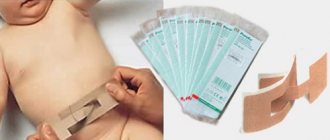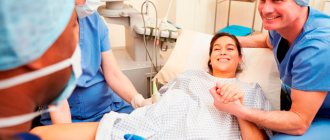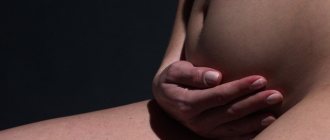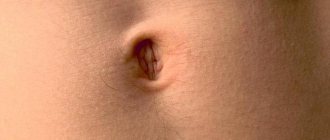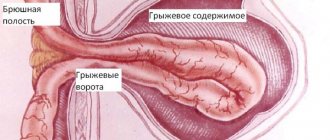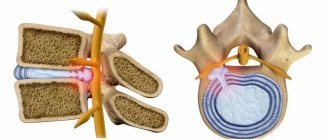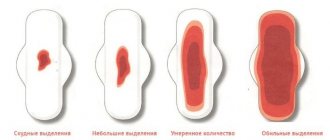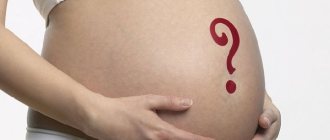Umbilical hernia after childbirth: causes
The main factor provoking the development of the disease is a prolonged increase in pressure developing inside the abdominal cavity and weakening of the muscles during gestation. The situation may be complicated by concomitant muscle diastasis or prolapse.
The following reasons are a serious reason for the development of the disease :
- Pathological course of previous births.
- Complications arising during childbirth.
- C-section.
- Carrying a large baby.
- Fluid accumulating in the abdominal cavity (ascites).
- Excess weight.
- Genetic predisposition.
- Previous surgical interventions.
An abdominal hernia after childbirth can behave differently. It all depends on the size of the hernial sac, consisting of one or more chambers. As a rule, the disease manifests itself in the second and third trimester and may look like this:
- A hernia after childbirth above the navel is far from the only type of disease that progresses while waiting for a baby. Weakening and stretching of muscle tissue, caused by constant pressure and changing hormonal levels, often leads to diastasis - this is what doctors call the separation of the rectus abdominis muscles. At the same time, the linea alba expands. In some cases, a hernia of the white line develops. After childbirth, if you notice obvious visual physiological changes or experience doubts and fears, be sure to take the time to consult a surgeon. This type of hernia cannot be treated conservatively and can only be repaired in the operating room.
- After a cesarean section, a ventral hernia may develop, which can also only be eliminated surgically.
- A spinal hernia after childbirth develops in the lumbar region in the absence of a strong muscle corset and lifting heavy loads. The cause may be increased load on the lower spine and chronic fatigue. Intervertebral hernia after childbirth is quite painful and requires treatment by a neurologist. Therapy involves taking non-steroidal drugs that relieve inflammation, muscle relaxants, antidepressants and physiotherapeutic procedures.
I recommend: How to cope with the difficulties of breastfeeding after a caesarean section?
Risks for new mothers
If this disease manifests itself during pregnancy, then the woman develops constipation, intestinal motility worsens and intrauterine pressure increases and the chances of pinching the hernial sac.
If the disease develops after the birth of a child, then:
- there are disturbances in the adequate blood supply in the abdominal cavity;
- often worried about the feeling of fullness in the intestines;
- there is intense pain;
- Internal organs may become displaced (this provokes disturbances in their functions).
Those mothers who have had or have:
- Multiple pregnancy.
- Deviations after natural childbirth.
- Unsuccessful cesarean section.
- Abdominal injuries.
- Strip operations up to "position".
- Connective tissue problems.
The causes of impaired muscle elasticity can be different: weak muscles that are prone to stretching, widening of the opening in the white line of the abdomen, or increased intrauterine pressure.
How does the development of the disease begin?
Many women are interested in what a hernia looks like after childbirth. The disease develops in stages:
- At first, a round or oblong bulge appears from time to time and disappears on its own. At this stage, the main problem is a cosmetic defect, there is no pain. Most often, the first visualization occurs when coughing. However, this is not a reason to ignore the symptoms. If an umbilical hernia appears after childbirth, what to do should be decided together with a surgeon practicing in a hospital.
- At the second stage, in an upright position of the body, the hernia protrudes constantly and disappears if you lie down. Light pressure eliminates the bulge, the internal organs take the correct position, there is no discomfort or pain.
- The third stage is accompanied by the formation of adhesions. Reduction at this stage is impossible, discomfort and acute pain appear, sometimes nausea, vomiting, increased body temperature, and hardening of the hernial sac.
If diastasis is present, the hernia develops quite quickly after childbirth. You should avoid physical activity; heavy lifting is especially contraindicated.
A hernia after childbirth above the navel or in another area is diagnosed quite easily: the surgeon palpates the abdomen. If in doubt, an ultrasound examination, gastroscopy or radiography of the peritoneum is additionally prescribed. Do not delay your visit to the doctor; treatment should begin immediately. A formation that cannot be reduced cannot be removed on its own, and lost time can lead to complications such as intestinal stagnation, strangulation, inflammatory processes and tissue necrosis. I hope now you understand how serious this is? Then let's talk about preventing this dangerous pathology.
Appearance mechanism
This is a disorder in the peritoneum and internal organs. During the period of bearing a child and during pushing, the abdominal muscles and the umbilical ring are very tense and can separate, which, in turn, leads to protrusion.
Strong intrauterine pressure causes the connective fibers to stretch, and the vertical abdominal muscles, which hold the organs inside, gradually diverge. As a result, the lady may develop diastasis and various types of formations above the navel.
This complication appears gradually. At the initial stage, the hernial sac is filled with contents. When lifting weights, it falls into the lumen of the umbilical ring. When the reason that provoked it disappears, it also disappears back. But in more advanced cases, it appears even in a standing position, and “hides” back only in a lying position. This does not bring much discomfort, since the formation comes back on its own, without additional effort.
Complications end with the formation overgrowing and connecting with the protruding tissue. With such symptoms, the protrusion can no longer be reduced. This causes pain. Failure to treat an umbilical hernia in women after childbirth entails serious consequences.
Hernia after childbirth on the abdomen: what can be done to prevent it?
It is no secret that any disease is much easier to prevent than to treat. To slow down the progression of the disease, it is enough to follow the following recommendations:
- Do not overexert yourself after childbirth: physical activity should be strictly dosed. Your desire to get back in shape as quickly as possible is understandable and natural, but your priority should be not beauty, but health.
- Perform a set of exercises aimed at strengthening the peritoneum (after consultation with your doctor). No matter how much a hernia after childbirth worries you, exercises can be performed no earlier than a month after natural delivery, and two months after a cesarean section.
- Wear a postpartum and prenatal bandage. Moreover, with today’s variety of choices of medical products, you can choose cute models for absolutely all sizes.
- Don't lift heavy objects.
- Watch your diet and regular bowel movements.
I recommend : What should a mother's diet be like while breastfeeding a newborn?
Symptoms
It is not possible to immediately determine the formation of a hernial sac in a nursing mother:
- The hernia gradually begins to protrude through the umbilical ring. This phenomenon can be especially noticeable during physical activity. After some time of rest, the hernial sac ceases to stand out;
- If measures are not taken to eliminate the pathology, hernial protrusion becomes regular when the nursing mother is in an upright position;
- The next stage of a umbilical hernia in a mother who is feeding her baby with breast milk is the formation of adhesions of the tissues of the umbilical region and the hernial sac;
- Abdominal pain appears, which is sharp.
Diagnosis of umbilical hernia in a nursing mother
A doctor will be able to diagnose an umbilical hernia in a nursing mother if it occurs after surgery through an external examination and using the palpation method. Often, in the last months of pregnancy, doctors can determine the body’s predisposition to the appearance of a navel hernia in the future.
In other cases, an abdominal ultrasound may be required to make a diagnosis.
The doctor may send a nursing mother for an X-ray examination.
Umbilical hernia after childbirth: how to determine the treatment method
As we have already found out above, this disease is subject to conservative or surgical treatment. Taking medications, as well as traditional medicine, can somewhat improve the situation if the hernia needs to be repaired. Surgeons are quite skeptical about therapy, because they believe that sooner or later, depending on the severity of the disease, you will be scheduled for surgery. My dears, do not panic, since the procedure is very common and is considered one of the simplest, leading to complications extremely rarely.
Official medicine offers a classic treatment regimen that involves taking antispasmodic drugs. The condition can be improved by the familiar nosh-pa (dratoverine), papaverine or other remedies recommended by a doctor. It is better to avoid self-medication. However, after consultation with the doctor, you can resort to traditional medicine. Let me tell you more about this?
Healers suggest using the following recipes
- Pour boiling water over the seeds or leaves of the drupe in the proportion of one tablespoon per glass of liquid and leave for 30 minutes. Take in small portions throughout the day.
- Finely chop the leaves and bark of the oak, pour in warm red wine. Use the resulting infusion for compresses. Exposure time - 3 hours.
- Grind aspen bark and pour boiling water over it. The infusion is prepared for about two hours and taken 3 times a day before meals.
- The hernia can be lubricated with camphor oil and pine resin placed on top. The holding time should not exceed 5 minutes. Be sure to monitor your health to avoid burns!
- Grind young nettle leaves in a blender and apply to the hernia, placing a plantain or cabbage leaf on top. This compress is applied for at least three hours. A warm scarf will enhance the effectiveness of the procedure.
- Dry heat will help relieve swelling and pain. Warm up the salt, pour it into a linen bag and apply it to the navel area.
After the above tips, I would like to once again focus your attention on the fact that the first place you should go is the surgeon’s office, who will help you choose the right treatment regimen.
Methods of surgical treatment
Modern medicine offers two methods to eliminate the problem:
- Hernioplasty (tension plasty), during which the walls are strengthened and the muscles of the umbilical ring are sutured.
- Implantation (tension-free plastic surgery) with the introduction of a special mesh to close the enlarged hole. It is performed when your own tissues are not enough to strengthen the abdominal muscles.
The surgical intervention lasts from 30 to 120 minutes. The choice of anesthesia depends on the patient's medical history. For small formations, local anesthesia is quite sufficient, and large hernias are removed only under general anesthesia, which can be masked or intravenous. With local anesthesia, swelling of the area remains for 48-96 hours.
Features of tension hernioplasty
To remove an umbilical hernia after childbirth, the surgeon needs to excise the hernial sac, fix the internal organs in the correct position and strengthen the peritoneal tissue by suturing the muscles and tendon plate. The method is used if the diameter of the resulting expansion does not exceed 3 cm. Hemming depends on the dissection of the umbilical ring:
- The Sapezhko method involves longitudinal dissection, interrupted sutures are applied, performed separately, or suturing is performed, reminiscent of the outline of the letter “P”.
- The Mayo method is used if the dissection is made transversely, the sutures are placed along the outline of the letter “P”.
Catgut is used as a suture material, which self-absorbs, is well tolerated by patients and does not require additional manipulations. The suture area is anesthetized during the first two days after the intervention.
The disadvantages of the method are relapses, pain for 20-80 days and a long recovery process. It is better to wait six months for your next planned pregnancy.
Implantation – plastic surgery without tissue tension
The operation is performed if the hernia has reached a large size. The implant is a mesh, the special weaving of which perfectly supports the internal organs and strengthens the peritoneum. Surgical intervention is minimized using a laparoscope - a special tube with a built-in camera, lenses and cold light lamps. The method avoids abdominal incisions. An umbilical hernia in women after childbirth is reduced by pumping carbon dioxide, after which an endoprosthesis (implantable mesh) is applied.
The obvious advantages of the methods are short rehabilitation and rare relapses. The full recovery period ranges from 3 to 7 weeks.
Signs
At the initial stage, protrusion of abdominal tissue appears occasionally. It is hardly noticeable. But with the further development of the pathology it becomes visible to the naked eye. The size of the hernial sac directly depends on the degree of damage; it can range from 2 to 18 cm.
The next symptom is pain, which intensifies with physical labor, sneezing and coughing. Progress in the development of an umbilical hernia is fraught with disturbances in the functioning of the gastrointestinal tract, the appearance of discomfort and a feeling of heaviness in the abdomen, and nausea.
Complications can arise in the form of strangulation, inflammatory processes and disturbances in the passage of feces in the large intestine. But the most dangerous infringement occurs when the blood supply to the protruding hernial sac is interrupted, which causes its necrosis. This pathology can be identified by sharp sudden pain in the navel, increased body temperature, general intoxication of the body, hardening of the hernial sac and increased local temperature. In the latter case, urgent surgery is necessary.
Symptoms of umbilical hernia in women:
- A peculiar bulge in the navel area. Its dimensions, depending on the severity and degree of the disease, can range from 2 to 18 cm.
- Pain that gets worse with exercise. Noticeable even when coughing and sneezing.
- Discomfort in the gastrointestinal tract. Disturbances associated with the process of emptying and flatulence appear.
If you ignore the first manifestations of this disease after the birth of a child, the following may develop:
- pinching of muscle fibers;
- inflammation of the peritoneum;
- disruption of the movement of feces;
- death of navel tissue when pinched (necrosis).
Necrosis is the most dangerous deviation in this pathology after childbirth. Its signs:
- sharp and sudden pain in the navel area;
- rapid increase in temperature;
- dizziness and weakness;
- vomit;
- loose stools;
- hot hernial sac (if you touch it).
Carrying out the operation
Access
carried out through the abdominal wall using a laparoscope.
A laparoscope is a narrow tube with a video camera and lighting elements.
The probe is inserted through a small incision near the navel. In addition to this incision, two more punctures are made for troacors (surgical instruments that penetrate the body cavity). Next, carbon dioxide is pumped in, the hernia is released and reduced. Afterwards, the wound is closed using an endoprosthesis, that is, a mesh.
The positive aspects of this method include:
- fabrics are not stitched or stretched;
- relapses are less common than with tension hernioplasty;
- the procedure lasts no more than an hour;
- short rehabilitation period.
Feelings after surgery
May be observed (purely individually):
- numbness of the wound site for 1-3 days;
- redness is present for 3-6 days;
- pronounced swelling in the wound area for 1-4 days;
- fever 1-2 days;
- pain for 2-4 days.
Treatment and therapy
Methods and therapy depend on the severity of the disease. At the initial stage, the disease can be successfully cured using a conservative method and performing light exercises to strengthen the muscles. In more complex situations, especially if a connective tissue disease is detected, surgery is prescribed.
These techniques are used only to correct the reducible type of the disease. The treatment is aimed at strengthening muscles naturally. And this is facilitated by individually selected exercises and a massage course. Certain procedures are prescribed to restore the functions of internal organs and to prevent constipation.
It happens that doctors recommend wearing a special bandage. It helps prevent an increase in the size of organ protrusion and the development of complications from strangulation. A bandage is very useful if other types of therapy are prohibited. The doctor will inform you how to put it on correctly.
Surgical treatment
Surgery is recommended for unreducible hernia. If the abdominal area can no longer recover on its own, then it needs to be corrected through surgery. This type of procedure has ceased to be traumatic, since it does not involve abdominal resection.
This method has many advantages over abdominal surgery:
- After laparoscopy there are no stitches left.
- There is no need to stay in the hospital ward for a long time.
- The procedure is painless and there is no need for long-term rehabilitation after it.
To remove the protrusion of organs, several punctures are made, trying not to disrupt the integrity of the muscle tissue. After its removal, the patient can return to normal life after 2-4 days. This type of treatment eliminates relapse.
But there are certain contraindications for laparoscopy:
- acute diseases of various origins;
- second half of the gestation period;
- lung ailments;
- cardiovascular pathologies.
How does the navel change during pregnancy?
articles: At the beginning of the second third of gestation, the fetus begins to quickly gain weight and increase in size.
This is accompanied by an increase in abdominal circumference. During the 20-25 weeks of pregnancy, many women experience an enlarged navel. It becomes larger, while the navel sticks out so that it is visible even under clothes. But don’t worry, these are just anatomical changes in the mother’s body that do not pose a danger to the fetus.
In order to determine the nature of the navel enlargement, it is worth turning to the physiology of changes in the female body during pregnancy. As the abdomen grows, the tension in the outer peritoneal wall increases. The skin on the abdomen becomes thinner and increases in size. The umbilical ring also increases.
At the same time, the fetus increases the load on the pelvic and digestive organs, trying to get comfortable. Many people start looking on the Internet for the answer to the question: will all pregnant women have a belly button protruding or not? In fact, it doesn’t come out for everyone.
But do not worry if you encounter this phenomenon and itching appears in the localization of the umbilical ring. The reason for this may be the process of its gradual increase. These are simply physiological features that do not have negative consequences for the fetus.
If your belly button suddenly retracts during pregnancy, you should consult a specialist. The size of the navel convexity depends on the following factors: • body weight; • percentage of collagen in the skin; • degree of pumping of the abdominal muscles; • number of children born; • age; • mass and child.
The degree of enlargement of the umbilical node is also influenced by the race of the mother. Navel enlargements cannot be changed. An enlarged navel during early pregnancy is not a violation. After pregnancy, the navel will still take on its original prenatal shape.
The umbilical knot in pregnant women cannot be untied. This can only occur in newborns if the umbilical cord is not tied correctly at birth.
Changing the color of the navel during pregnancy is not a pathology. This is quite natural. During pregnancy, the body is completely rebuilt. There is a strong hormonal imbalance.
Adrenal hormones begin to work in a more intense mode, which increases the production of skin pigments, and a dark navel appears. If your navel darkens during pregnancy, don’t be alarmed. This is facilitated by the accumulation of pigments in the body.
Signs such as: • darkening of the navel; • a brown stripe from the navel appears on the stomach of pregnant women; • changes in the color of the nipples and the area around them; • the covering of the skin with pigment spots.
Pigmentation, which appears due to changes in hormones, disappears within a few months after the fetus is removed from the mother's body. The only exception is the halo color. It remains unchanged until the end of life.
Minor pain in the area of the umbilical ring is not a deviation from the norm. It may appear due to excessive tension of the skin with an increase in the volume of the abdomen. If you have severe spasms in the area of the umbilical node, you should consult a gynecologist. This may be a signal for the formation of an umbilical hernia.
If it is very noticeable and painful, you should immediately seek help from a specialist. But there are also signs by which you can determine the presence of a hernia yourself. Here are some of the symptoms: • compaction near the umbilical area; • pulsating beats in the abdomen; • intestinal obstruction and constipation; • excessive protrusion of the umbilical node; • the appearance of nausea.
In order to make a diagnosis and assess the severity of the hernia, it is necessary to consult a specialist.
The solution to this problem may be a small operation with local anesthesia or a number of recommendations: • use of a prenatal support bandage; • daily use of specialized ointments and creams; • avoid intestinal problems - eat a balanced diet so as not to cause additional stress on the hernia.
If the navel hurts during pregnancy, this may indicate a disruption in the functioning of the stomach and intestinal systems. Disturbances may be associated with chronic diseases of the digestive system or as a consequence of intestinal infection.
Cases of appendicitis during pregnancy are less common. In this case, you need to calm down and wait for the doctor in a comfortable position. Symptoms of appendicitis are: a sharp increase in temperature, vomiting and pain in the lower right part of the abdomen.
Attention: self-medication for suspected appendicitis is inappropriate!
It is better to remove the jewelry from the navel as soon as you find out you are pregnant. Many obstetricians and gynecologists are against piercing. It creates discomfort during the third trimester. Important: piercing while pregnant is completely contraindicated. When piercing, there is a high risk of infection, and even pus may occur.
Folk signs
Our ancestors also determined the sex of the child by the shape and size of the abdomen, and the mother’s eating preferences. It turns out that the sex of the baby can also be determined using changes in the navel. Women with an acute belly were predicted to have a boy. Therefore, the family prepared blue clothes for the baby. A wide belly, on the contrary, indicated the birth of a girl. Today, superstitions are not taken seriously.
In practice, the sex of the child and the navel depend on heredity, and does not in any way affect changes in the shape of the abdomen of the expectant mother. The navel may change during pregnancy. This is a natural process that does not need to be corrected or treated. During pregnancy, you should enjoy this wonderful time and, of course, take a couple of pictures with your rounded belly.
Clinics in your city
Discharge after conception
Swelling of the legs during pregnancy
When a woman is pregnant, the amount of fluid in her body doubles. In this regard, a woman may suffer from swelling of the legs during pregnancy. This phenomenon itself...
Clostilbegit when planning pregnancy
Stimulation of pregnancy by clostilbegit occurs due to the drug’s effect on the hypothalamus.
Starting from the second half of pregnancy (approximately at the 25th week of pregnancy, however, this happens strictly individually for each woman, which is why changes may occur a little earlier or later), a gradual protrusion of the navel begins. Over time, the navel begins to look like a small button.
After childbirth, the navel may return to its previous shape, but this may not happen in every girl. However, at the same time, at approximately seven to eight months of pregnancy, a decrease in its depth may be observed.
Changes in the navel during pregnancy are associated with the growth of the abdomen. As a rule, in the first trimester this part of the body does not bother expectant mothers. The navel comes out only after the 20th week of pregnancy. At this stage, it takes on the appearance of a small button. Such changes are absolutely normal for all women. If the umbilical ring turns out slightly and does not cause pain, there is no cause for concern.
Navel protrusion
Why does my belly button stick out? During late pregnancy, the uterus fills the entire abdominal cavity, there is very little space there, and the umbilical cavity fills up. If the expectant mother is not overweight, her belly will not change much. In obese women, the navel may protrude more. “Skinny people” often don’t even face the problem when their belly button comes out.
Sometimes, in slender mothers, the navel may begin to protrude already in the first months of gestation. This is due to weak abdominal muscles. Changes in the navel occur earlier in women carrying a second pregnancy after a recent birth. The reason that the navel has begun to protrude is multiple births or polyhydramnios. Such situations lead to an enlarged belly.
Color change
In many women, in the last trimester, the navel darkens, and a dark stripe appears along the central line of the abdomen (more details in the article: why does a dark stripe appear on the stomach of pregnant women?). These changes are caused by hormones. Generally, the darkening goes away completely within a couple of weeks after giving birth, so you shouldn't try to cleanse dark skin.
We suggest you read: Folk remedies for runny nose during pregnancy
When should you worry? When the navel during pregnancy not only darkened, but turned blue. This is a possible sign of an umbilical hernia. Blue discoloration in this area may indicate other pathologies - cystitis, fetal death, appendicitis, umbilical cord entanglement of the fetus. In this case, in addition to a bruise, discomfort appears in the area of the umbilical ring.
Painful sensations
Unpleasant sensations in the navel bother almost all expectant mothers. They are associated with an increase in abdominal size and increased stress on the abdominal muscles. Because of this, pain occurs in the umbilical ring, which is greatly stretched. For this reason, a burning and itching sensation often appears in the navel.
The navel sometimes hurts during pregnancy due to spraining of the ligaments that are located near the liver. The pain in this case is short-term.
Other changes
Useful video: the whole truth about the navel
What causes navel changes during pregnancy and are they dangerous? — revealing secrets about pregnancy on Pitanie4Zdravie.ru
Pregnancy makes a woman truly beautiful. But during pregnancy, many questions arise that need to be answered. Especially for you, in the “Pregnancy from A to Z” section, we publish interesting and useful articles about pregnancy, so that this wonderful time for you will be as “problem-free” and joyful as possible.
You can also find here the main signs of pregnancy, how the baby’s fetus develops at different stages of pregnancy, understand what is possible and what is not possible at different stages of pregnancy. Learn more about the effect of various foods, vitamins (for example, the effect of folic acid) on pregnancy.
Non-tension hernioplasty
If the surgical intervention is not performed using tension plastic surgery, then synthetic implants are used. Implants are mesh. Mesh implants differ in manufacturer and price.
For example:
It is recommended to place an implant for large hernias. After 6 months they are indistinguishable from tissue. Mesh implants are well tolerated, thanks to modern weaving technologies, patients do not even feel them. Since such an operation takes a long time, general anesthesia (intravenous or mask) is used. Only 5% of tension hernioplasty operations are performed under local anesthesia.
Complications
Why is a navel hernia dangerous for a nursing mother? If you do not consult a doctor in a timely manner, dangerous consequences of the disease may occur:
- Coprostasis is the accumulation of feces in the intestines. With early diagnosis, treatment is carried out using conservative methods without hospitalization. A nursing mother should take medications to help restore bowel function. If conservative treatment is ineffective, surgery is performed;
- Injury to internal organs can also be a serious complication of an untreated umbilical hernia. Due to the strangulation, tissue necrosis occurs, which leads to peritonitis. If surgery is not performed, death is possible;
- Intestinal upset, constipation and stool disturbances are less dangerous consequences of an umbilical hernia not repaired in a timely manner in a nursing mother.
Postoperative period
Lasts 3-7 weeks, it all depends on the patient. If a woman follows all the doctor’s recommendations, she will soon lead her usual lifestyle. The scar is small and almost invisible. Pregnancy after surgery Polypropylene mesh is an excellent barrier to recurrent intestinal fragment prolapse without being felt by the woman. And the self-absorbable material dissolves without a trace in the tissue, which is suitable for the female sex who is planning a pregnancy. The mesh does not create problems in bearing a child. The pregnancy is proceeding well, without pathologies or complications.
This condition occurs in some women after they give birth to a baby. The disease worries women and causes discomfort. It would seem that the most difficult thing is over - the process of carrying the baby is over, the birth has been successful, but here a new problem appears.
Hernia during the postpartum period, especially after the birth of children with high birth weight, is quite common. This condition requires careful attention; one cannot ignore a postpartum hernia. A timely visit to the doctor and taking the necessary measures will help get rid of the problem and protect against its consequences. So, let's look at it in detail.
